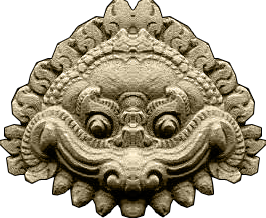
Other Javanese Figurines
The names of Hindu deities used in India are often replaced by local names in Java. Shiva became known as Bathara Guru and, with his consort Bathari Uma (Parvati), had a son who was known as Bathara Kala. The image above shows a Javanese Kirtimukha. In Java this, together with dvarapala (guardian of the door or gate) statutes, with a similar fierce face, would be identified with Bathara Kala. It is found above many entrances on Javanese temples.
The Kirtimukha or Face of Glory is also found in many Indian temples, but some Javanese versions seem to have developed independently. The original Indian description is: The Kirtimukha is a mask made up of the face of the Lion (Simhamukha), of the Death’s head (Kala) and the Dragon’s head (makara or naga).[1] The dragon component has no chin and most Kirtimukha images in India have no chin, perhaps also to fulfil the symbolism that the mouth must never be closed. The numbered images are part of the Apsarah Gallery Collection.
Kirtimukha Torana, Candi Kidal
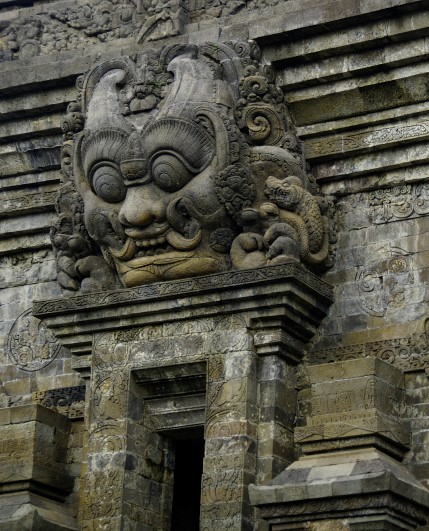 Material: andesite stone
Material: andesite stone
This is a typical Javanese Kirtimukha installed as a torana (entrance decoration) over the entrance of Candi Kidal, Tumpang, Malang East Java. Each entrance has a similar Kirtimukha.
The Kirtimukha or Face of Glory is most closely associated with Kala, but has a leonine appearance and a naga or makara (sea monster) at either side of the face. When complete with all the features it is referred to as a Kirtimukhamakara torana. This example was just too good not to be included on this page.
Singhasari Bathara Kala
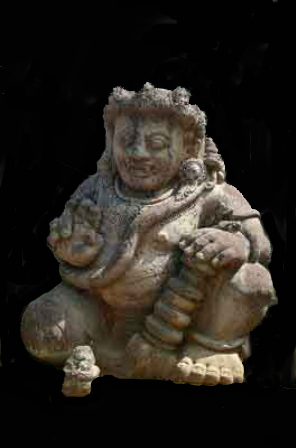 Material: andesite stone
Material: andesite stone
Posture: virāsana.
Attributes: The right hand perhaps shows a variation of the vitarkamudra and the left hand holds a gada (cudgel).
This is originally a Hindu deity placed outside of Javanese temples and palaces and is usually referred to as Bathara Kala and in Bali as Bhoma.
This statue, located at Singhasari, is 370 cm tall.
1. Bathara Kala
 Material: high zinc-tin copper alloy.
Material: high zinc-tin copper alloy.
Patina: brownish grey.
Posture: virāsana.
Attributes: The right hand holds a gada (cudgel), and the left hand holds a naga (snake).
This Hindu deity in Javanese tradition is usually referred to as Bathara Kala and in Bali as Bhoma.
Plaosan Temple Guardian
 Material: andesite stone
Material: andesite stone
Posture: virāsana.
Attributes: The right hand perhaps holds a naga snake and the left hand holds a gada (cudgel).
This statue is located near the Buddhist Plaosan Temple, is 430 cm tall and is the largest of its type in Java. The statue is referred to as Bathara Kala, however, it lacks the ogre-like characteristics of Bathara Kala and I would contend that this in fact is Shiva Mahakala in his capacity as a Dharmapala (Protector of the Dharma) following Mahayana and Vajrayana traditions and not Bathara Kala the Javanese God of the Underworld and son of Shiva.
It is difficult to determine the names or significance of some the items in this part of the collection. They all presumably originated in Java and some may be related to the Javanese versions of the Hindu Ramayana or Mahabharata or indigenous Javanese stories. Many changes were made to the original Vedic texts after they were adopted in Java.
2. Ghatotcaca
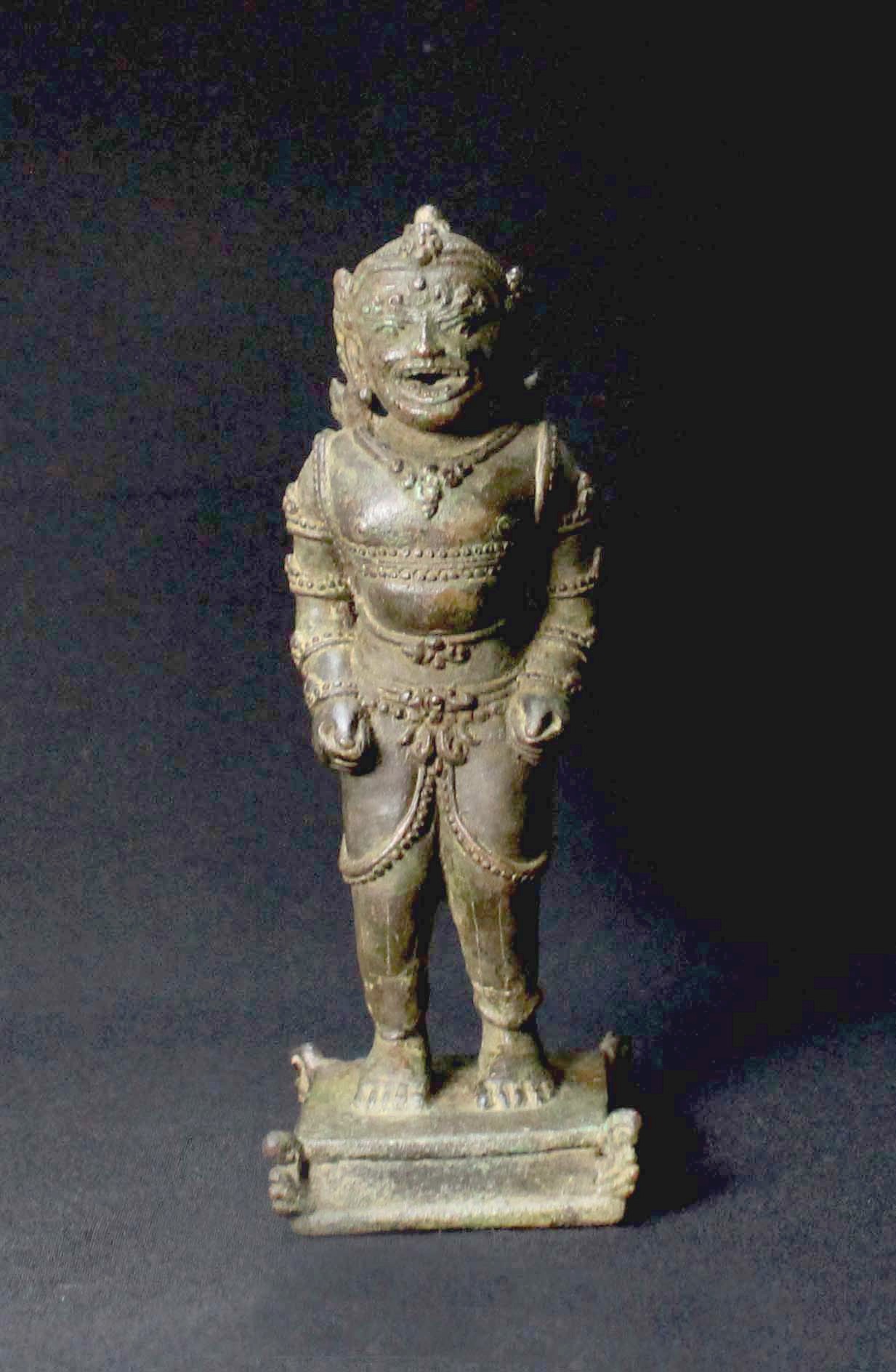 Material: bronze
Material: bronze
Patina: greenish brown.
Posture: sampada.
Attributes: Both hands show mushti (clenched fists).
After difficulties in identifying this figurine, we received a suggestion from a viewer that it was Gatotkaca. We had not associated this figure with the Ghatotkaca from the Indian version of the Mahabharata. However, after further examination and reading various Javanese versions the story about him, we agreed. The name Ghatotkaca means bald pot, or as we would say bald pate, and comes from the Sanskrit ghaṭa, pot and utkaca, hairless. We had been confused that the figure appears to be of a child and may be explained in some of the Javanese versions of the stories, which vary widely.
Ghatotkaca was the son of the Pandava Bhima and the Rakshasi Hidimbi, so he was half Rakshasa. In the Javanese version, when he was still young, he was thrown into a crater followed by many weapons. When he emerged, the weapons had melted and become one with him. He then went on to kill a Rakshasa enemy with a bite. He is described in Javanese as having otot kawat balung wesi, or wire muscles and iron bones. He had many magical powers such as the ability to fly, to increase or decrease his size, and to become invisible. He became an important powerful fighter on the Pandava side in the Kurukshetra war.
3. Ghatotkaca
 Material: bronze
Material: bronze
Patina: greenish brown.
Posture: sampada.
Attributes: Both hands show mushti (clenched fists).
After difficulties in identifying this figurine, we received a suggestion from a viewer that it was Gatotkaca. We had not associated this figure with the Ghatotkaca from the Indian version of the Mahabharata. However, after further examination and reading various Javanese versions the story about him, we agreed. The name Ghatotkaca means bald pot, or as we would say bald pate, and comes from the Sanskrit ghaṭa, pot and utkaca, hairless. We had been confused that the figure appears to be of a child and may be explained in some of the Javanese versions of the stories, which vary widely.
Ghatotkaca was the son of the Pandava Bhima and the Rakshasi Hidimbi, so he was half Rakshasa. In the Javanese version, when he was still young, he was thrown into a crater followed by many weapons. When he emerged, the weapons had melted and become one with him. He then went on to kill a Rakshasa enemy with a bite. He is described in Javanese as having otot kawat balung wesi, or wire muscles and iron bones. He had many magical powers such as the ability to fly, to increase or decrease his size, and to become invisible. He became an important powerful fighter on the Pandava side in the Kurukshetra war.
4. Ghatotkaca
 Material: bronze
Material: bronze
Patina: dark brown.
Posture: sampada.
Attributes: Both hands show mushti (clenched fists).
After difficulties in identifying this figurine, we received a suggestion from a viewer that it was Gatotkaca. We had not associated this figure with the Ghatotkaca from the Indian version of the Mahabharata. However, after further examination and reading various Javanese versions the story about him, we agreed. The name Ghatotkaca means bald pot, or as we would say bald pate, and comes from the Sanskrit ghaṭa, pot and utkaca, hairless. We had been confused that the figure appears to be of a child and may be explained in some of the Javanese versions of the stories, which vary widely.
Ghatotkaca was the son of the Pandava Bhima and the Rakshasi Hidimbi, so he was half Rakshasa. In the Javanese version, when he was still young, he was thrown into a crater followed by many weapons. When he emerged, the weapons had melted and become one with him. He then went on to kill a Rakshasa enemy with a bite. He is described in Javanese as having otot kawat balung wesi, or wire muscles and iron bones. He had many magical powers such as the ability to fly, to increase or decrease his size, and to become invisible. He became an important powerful fighter on the Pandava side in the Kurukshetra war.
5. Lord Rama
 Material: brass.
Material: brass.
Patina: dark grey.
Posture: arthapadmasana (half-lotus posture) on a vishvapadma throne with the right hand showing katakamudra, (closed hand), possibly was holding an attribute; and the left hand at rest.
The crown is a keśabhanda makuṭa.
Lord Rama is considered as the seventh avatar of Lord Vishnu.
The provenance of this item is not known, but it is thought that it may have come from Bali.
6. Maricha
 Material: brass.
Material: brass.
Patina: coppery yellow
Posture: atibhangha
Attributes: The right hand holds his right horn and the left hand is in katakamudra, perhaps holding an object.
Maricha is the rakshasa uncle of Ravana who arranges the kidnapping of Sita by Ravana in the Ramayana.
7. Prabhu Menak Jingga
 Material: brass.
Material: brass.
Patina: coppery yellow
Posture: atibhangha.
Attributes: The right hand holds a gada (cudgel) and the left hand shows katakamudra, perhaps holding an object.
Prabhu Menak Jingga was a powerful Lord or King of Blambangan, who wanted to marry a member of the Majapahit royal family. He possessed a gada (cudgel) that made him invincible, but was tricked into letting it be stolen and was defeated by Damarwulan, a prince who was sent from Majapahit. This is a well known story in East Java and is played out in the wayang performances.
8. Srikandi
 Material: bronze
Material: bronze
Patina: brown, fine finish
Posture: abhanga.
Attributes: The right hand holds a chapa (bow) and the left hand in the vitarkamudra showing deliberation.
Srikandi was a figure in the Mahabharata epic. There are various stories about rebirth and a change of sex. The Javanese versions differ from the Indian version. Depending on the version, Srikandi was born as a girl and changed into a man.
9. Dipadana – Bearer of Light
 Material: bronze
Material: bronze
Patina: greenish brown.
Posture: pratyalidha, extending the left leg. A stance sometimes taken by an archer.
Attributes: The right hand holds a dipa (lamp) and the left hand holds a cylindrical open ended tube, perhaps for placing a miniature parasol.
The figure is mounted on a tubular finial perhaps for a parasol.
King Samaratungga and Queen Tara
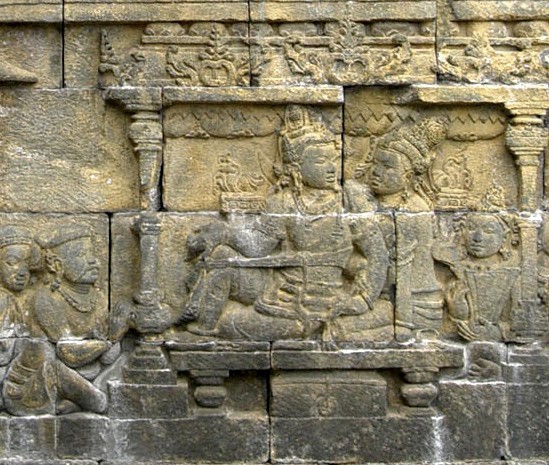 This relief, sculpted on the walls of Candi Borobudur (completed 825 CE), shows a royal couple at ease with their attendants. It is most probably that of King Samaratungga and Queen Tara. Samaratungga, who was the head of the Shailendra dynasty in the 8th century, initiated the construction of the Buddhist monument Borobudur. Samaratungga had married Dewi Tara, the princess of Srivijayan Maharaja Dharmasetu, creating an alliance between the Shailendras and the Srivijaya Empire in Sumatra. Here the king is shown in rajalilasana (posture of royal ease) with the queen kneeling at his side.
This relief, sculpted on the walls of Candi Borobudur (completed 825 CE), shows a royal couple at ease with their attendants. It is most probably that of King Samaratungga and Queen Tara. Samaratungga, who was the head of the Shailendra dynasty in the 8th century, initiated the construction of the Buddhist monument Borobudur. Samaratungga had married Dewi Tara, the princess of Srivijayan Maharaja Dharmasetu, creating an alliance between the Shailendras and the Srivijaya Empire in Sumatra. Here the king is shown in rajalilasana (posture of royal ease) with the queen kneeling at his side.
10. Javanese King and Queen
 Material: bronze high relief.
Material: bronze high relief.
Patina: greenish brown.
It is possible that the figures are those of King Samaratungga and Queen Tara as shown in the above relief from Borubudur. It could also represent other famous royalty such as King Kertarajasa Jayawardhana, of Majapahit and one of his Queens. This king was the first monarch of the Majapahit empire and reigned from 1293 to 1309. He referred to himself as Nararya Sangramawijaya and was also later known as Raden Wijaya. Kertarajasa had taken the four daughters of the last king of Singhasari in marriage and also married a princess from the Malayan Dharmasraya kingdom in Sumatra. If it is Kertarajasa, the Queen is probably Indreswari the Malayan princess, who had acquired the title Stri Tinuheng Pura, literally the wife made senior in the palace, perhaps because she was the only wife that produced a male heir for the king. As in the above Borobudur sculpture, the king is shown in rajalilasana (posture of royal ease) with the queen kneeling at his side.
Queen Suhita of Majapahit
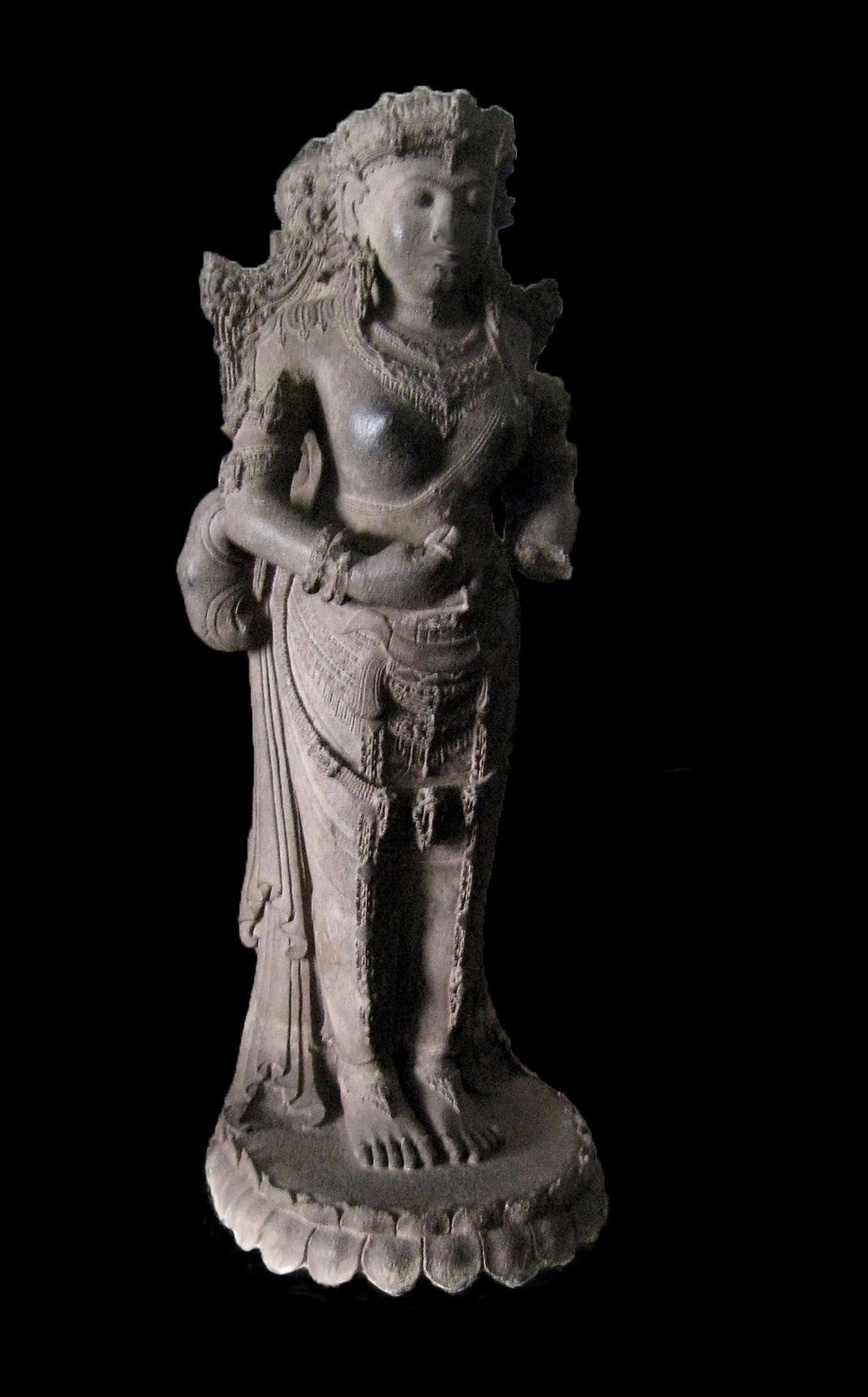 Material: andesite stone.
Material: andesite stone.
Posture: sampada on a vishvapadma. From the position of the left hand, the hands perhaps show the dharmacakramudra, but the lower part of the left arm and hand are missing.
The sculpture was found in Tulungagung Regency, East Java, has been identified as of Suhita, who was queen regnant of the Majapahit empire, from 1429 to 1447. The statue was presumably made after her death.
She is dressed in royal clothing, with pendants hanging from several girdles, a tiara, earrings, necklaces, bangles and anklets. During Suhita’s reign, there was a war with the Kingdom of Blambangan as described in the legend about Prabhu Menak Jingga q.v. and Dharmawulan.
11. Queen Suhita
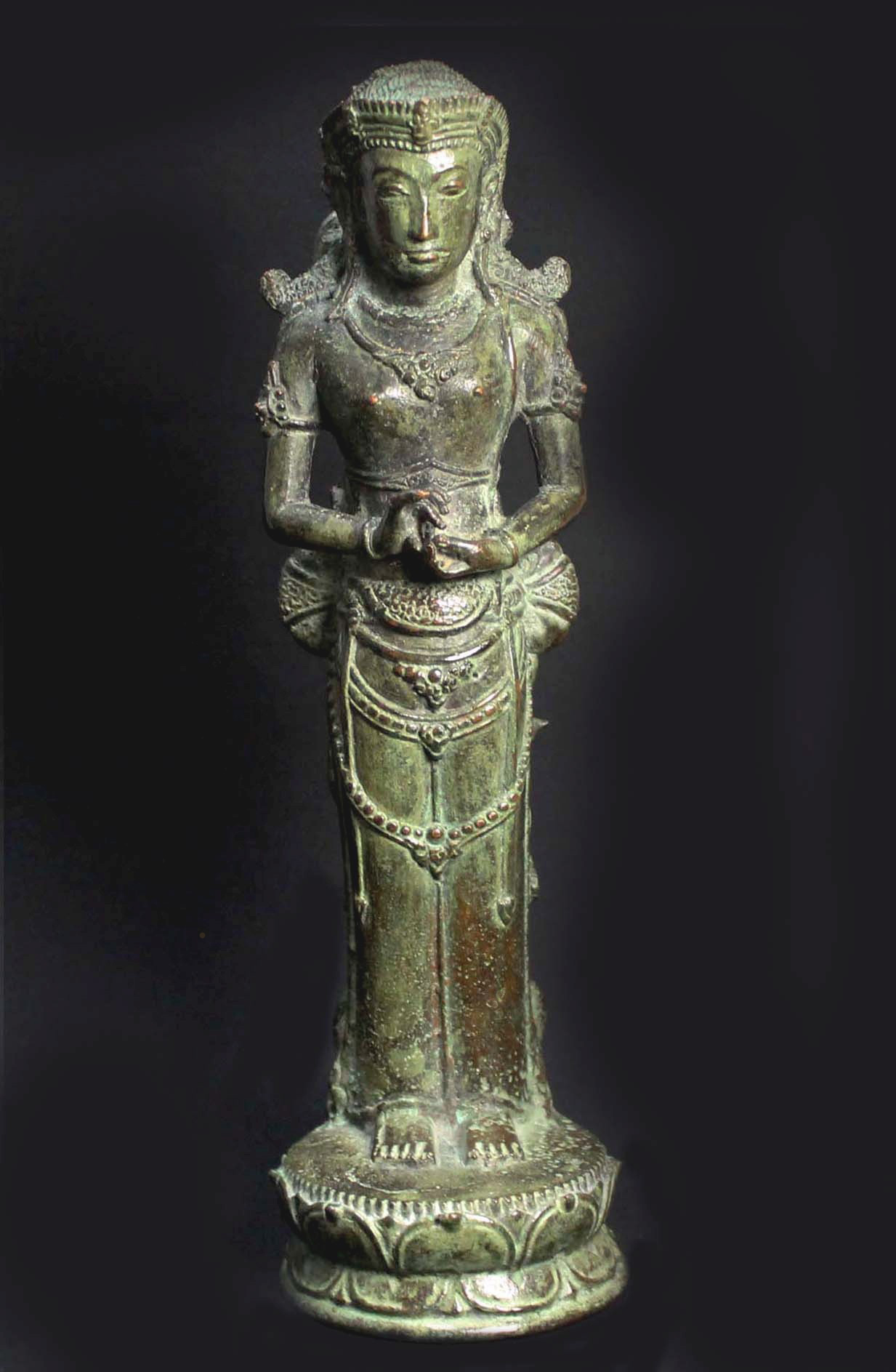 Material: bronze.
Material: bronze.
Patina: greenish-brown.
Posture: sampada on a vishvapadma, with hands showing the dharmacakramudra.
The figurine copies almost exactly the form, clothing, and ornamentation of the above stone statue. If the stone statue is showing the dharmacakramudra, then the positions of the hands are reversed, however, the position of the hands in the figurine is the more typical for this mudra.
On the back of this figurine is an elaborate depiction of lotuses climbing the entire length of the figure from the feet to the head. This, I have always felt, is a beautiful feature that sets it apart from all of the others, for which reason, it was chosen to feature on the home page.
11a. Queen Suhita – view of the back

This is the view of the back of the Queen Suhita figurine, showing the elaborate intertwined lotus plants with the stems, leaves, buds and flowers growing up the back of the figurine. This is not just a high relief: the stems are raised off the back surface. A side view of this may be seen on rotating image on the home page.
12. Man with Scroll
 Material: bronze.
Material: bronze.
Patina: brown, fine finish.
Posture: abhanga on a small socle.
Attributes: The hands hold a pustaka (scroll), or what might be a container for lime, as used in the preparation of areca nuts from the Areca catechu palm with betel leaves.
The dress is simple and there is no ornamentation except for a kankana (bangle) on each wrist. Perhaps he is a scribe or servant of a high-ranking person.
There appears to be Pallava or Hanacaraka script, perhaps in Kawi, on the socle, as yet undecyphered.
13. Kneeling Man
 Material: bronze.
Material: bronze.
Patina: greenish brown, fine finish.
Posture: kneeling, perhaps in prayer or obeisance, on a simple pedestal, with the hands resting on the legs.
The hair is tied in a small bun on the top of the head. He is wearing heavy earrings and a necklace with what appears to be a large shark’s tooth and two smaller ones. There is a heavy twisted cord cord around the waist.
Seated Female Ascetic
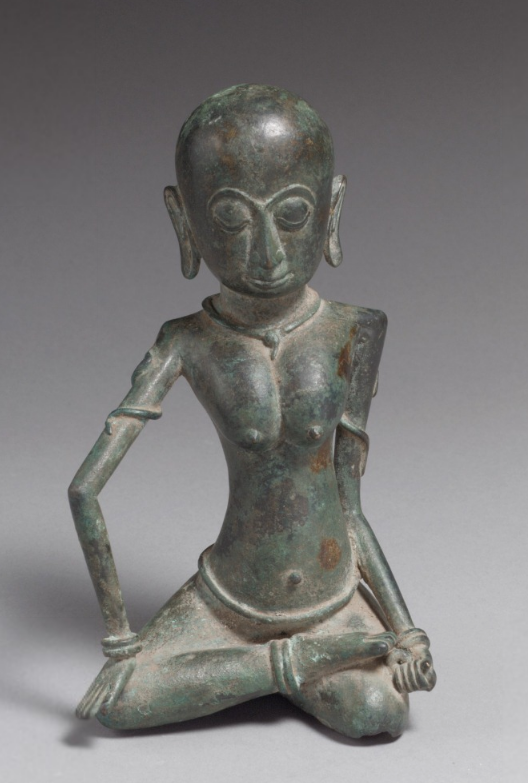 Material: bronze.
Material: bronze.
Patina: greenish brown, fine finish.
Posture:sitting on folded left leg, perhaps in prayer or meditation, without a pedestal. The right hand rests on the knee and the other perhaps in the katakamudra (holding an object).
This small bronze figurine measures 16.8 cm in height. It is in the collection of the Metropolitan Museum of Art, New York in the Heilbrunn Timeline of Art History, with the description: “Seated female ascetic [Indonesia (Java), Majapahit kingdom]” (1997.435). Her thin arms and shaved head suggest that this figure may represent an ascetic. She is seated with left leg folded beneath her, and wears a sarong, serpentine armlets, and a necklace with leaf-shaped pendants and bands around her wrists and ankles. She has a serene expression, heavy-lidded downcast eyes, and prominent arched eyebrows.
It is included as a simple, but beautiful example of bronze casting that has been authenticated as coming from the Majapahit period. It is particularly interesting because, although the subject matter is different, the facial features bear a remarkable similarity to those of Item No. 6 on the Images of the Buddha page. The Buddha image has more green patina, but the finish is similar and one could draw the conclusion that the alloys used for making the castings and workmanship are similar.
1. Hindu Temple by Stella Kramrisch (1991) p. 322 et seq.